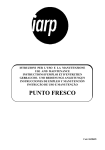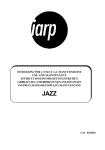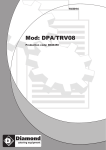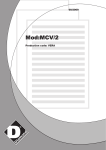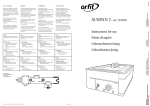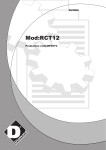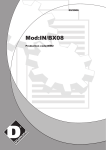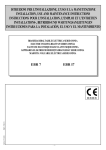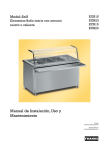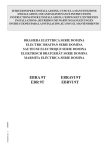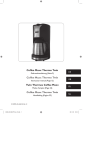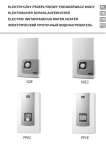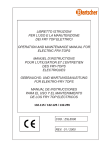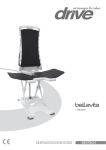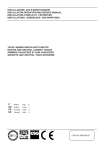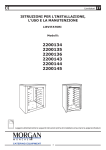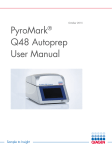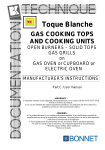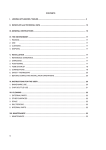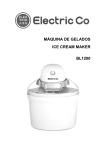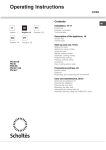Download Mod:BT12
Transcript
08/2006 Mod:BT12 Production code:BC3V7 “SELF-RO 70” I GB DE FR Bureaux/Showroom 8/16 RUE DE MOORSLEDESTRAAT 1020 BRUSSELS Tel: 02/420.26.26 Fax: 02/420.67.66 - MANUALE D’INSTALLAZIONE, USO E MANUTENZIONE PER ELEMENTI BAGNOMARIA - INSTALLATION, OPERATING AND MAINTENANCE MANUAL FOR BAIN-MARIE UNITS - INSTALLATIONS-, BEDIENUNGS- UND ARTUNGSANLEITUNG FÜR BAINMARIE-ELEMENTE - NOTICE D’INSTALLATION, UTILISATION ET ENTRETIEN POUR ELEMENTS BAIN-MARIE A010016 Rev. 5 Pagina 1 di 23 PDF created with FinePrint pdfFactory Pro trial version http://www.fineprint.com I MANUALE D’INSTALLAZIONE, USO E MANUTENZIONE PER ELEMENTI BAGNOMARIA SU ARMADIO NEUTRO O ARMADIO CALDO “SELF-RO 70” 1. AVVERTENZE Leggere con attenzione il presente Manuale prima di procedere all’installazione. Il Manuale è concepito per dare all’utilizzatore le informazioni necessarie all’impiego dell’apparecchiatura in condizioni di sicurezza, dal trasporto al momento dello smantellamento. Il manuale deve essere conservato con cura, per essere disponibile in caso di future consultazioni. In caso di cessione dell’apparecchiatura, il manuale deve essere consegnato al nuovo utente. Per un corretto utilizzo dell’apparecchiatura: • Non manomettere i dispositivi di sicurezza; • Utilizzare solo per gli scopi specificatamente previsti; • Non usare la vasca per il riscaldamento senza H 2O; • Evitare la presenza di personale estraneo in prossimità dell’apparecchiatura; • Impiegare per la manutenzione esclusivamente personale qualificato; • Disattivare l’apparecchiatura in caso di guasto o di funzionamento irregolare; • Utilizzare esclusivamente ricambi forniti dal Costruttore o da questi indicati. ATTENZIONE: L’ACCESSO AL QUADRO ELETTRICO PRINCIPALE E A TUTTE LE ALTRE PARTI ELETTRICHE, SIA PER L’INSTALLAZIONE CHE PER LA MANUTENZIONE, È AUTORIZZATO SOLO A PERSONALE QUALIFICATO. Il Costruttore declina ogni responsabilità per i danni a cose o persone causati dalla mancata osservanza delle istruzioni e precauzioni contenute nel manuale. Per qualsiasi dubbio o necessità rivolgersi al RIVENDITORE. 2. INTRODUZIONE L’apparecchiatura è conforme alle Direttive 89/336/CEE, 73/23/CEE e 93/68 CEE. Sono state inoltre applicate le norme CEI EN 60335-1, CEI EN 60335-2-49, CEI EN 60335-2-50, EN 55014, EN 61000-3-2 ed EN 61000-3-3. 3. DESCRIZIONE DELLE APPARECCHIATURE I nostri ELEMENTI BAGNOMARIA sono costituiti da una vasca inserita in un armadio di supporto, dal gruppo di riscaldamento alloggiato nella parte sottostante la vasca e da un gruppo di comando e controllo della temperatura vasca, inserito in un cruscotto verticale posto lateralmente nel vano sottostante. Il gruppo di riscaldamento è costituito da un numero di resistenze variabile (da 2 a 6) secondo la dimensione della vasca. Gli ELEMENTI BAGNOMARIA sono disponibili nelle dimensioni unificate GASTRONORM 2 1/1, 3 1/1, 4 1/1 e 6/1 come rilevabile in Tab. A per essere inseriti in impianti di ristorazione collettiva variamente configurati. 4. TRASPORTO E MOVIMENTAZIONE Se l’apparecchiatura viene trasportata su pallet deve essere scaricata mediante carrello elevatore o altro macchinario di sollevamento idoneo, manovrati da personale addestrato. Il peso massimo è indicato in Tabella A. Eventuali errori di manovra potrebbero causare infortuni per schiacciamento. Qualora le superfici dell’apparecchiatura subissero urti esse sarebbero immediatamente rovinate. In questa fase deve essere vietata la sosta nelle immediate vicinanze a chiunque non sia coinvolto direttamente nell’operazione. Il personale che effettua la movimentazione deve essere munito di mezzi di protezione personale adeguati (ad es.: guanti da lavoro, scarpe antinfortunistiche). 5. CONDIZIONI DI UTILIZZO E CARATTERISTICHE TECNICHE I nostri ELEMENTI BAGNOMARIA sono concepiti unicamente per mantenere ed esporre vivande riscaldate, contenute in appositi contenitori unificati, in locali adibiti alla ristorazione collettiva. Ogni altro impiego è da ritenersi improprio. La temperatura max di funzionamento della vasca è di 90° C, la temperatura max di funzionamento del vano caldo è di 60° C. Gli ELEMENTI BAGNOMARIA sono disponibili secondo le configurazioni riportate nella Tabella A. 5.1 Comandi e controlli I dispositivi di comando sono raggruppati sul cruscotto descritto in Fig. 1. I componenti elettrici sono a norma. 5.2 Protezioni e dispositivi di sicurezza • • • Dispositivi di sicurezza: Termostato di sicurezza a riarmo manuale solo nell’armadio caldo, regolato ad una temperatura di 150° che interviene in caso di funzionamento anomalo. Dispositivi di protezione individuale: Si consiglia l’uso di presine o guanti a causa della temperatura raggiungibile dai contenitori delle vivande o stoviglie riscaldate. Disposizioni particolari a copertura di rischio residuo: Limitare l’accesso alle sole persone addette, che devono essere informate sui pericoli potenziali dovuti alla temperatura. 6. INSTALLAZIONE 6.1 Operazioni preliminari A010016 Rev. 5 Pagina 2 di 23 PDF created with FinePrint pdfFactory Pro trial version http://www.fineprint.com I L’utilizzatore deve predisporre l’alimentazione elettrica secondo quanto riportato in Fig. 3 (nel caso di montaggio fisso), nel rispetto delle norme vigenti. Deve essere disponibile una conduttura d’acqua con pressione 1,5 - 3 Bar, dotata di valvola di intercettazione, per il carico vasca. L’acqua deve essere potabile e possibilmente demineralizzata. L’acqua può essere già pre-riscaldata a non più di 50 °C. Per lo scarico è necessaria una tubazione dotata di sifone. I tubi di carico e scarico predisposti sono entrambi da ½ “GAS. 6.2 Posizionamento Posizionare l’apparecchiatura con l’eventuale aiuto di un transpallet. Se questo spostamento avviene dopo il disimballo, proteggere le superfici dagli urti. L’apparecchiatura viene fornita di serie su ruote, se su piedini (optional) agire sui piedini regolabili per regolare l’altezza e compensare eventuali irregolarità o pendenze del pavimento. Durante questa fase controllare la corretta chiusura delle eventuali porte del vano sottostante. Una volta completata l’installazione è possibile togliere la pellicola protettiva. L’operazione va fatta molto lentamente per evitare che la colla rimanga sulle superfici. Qualora ciò avvenga, passare con kerosene o benzina. 6.3 Collegamenti idrici (montaggio fisso) Sotto il piano inferiore sono visibili i tubi di carico e scarico. Collegare il tubo di carico C alla conduttura utilizzando un tubo flessibile. Collegare lo scarico S della vasca al sifone della tubazione di scarico predisposta nel locale. Una volta completata l’installazione è possibile togliere la pellicola protettiva dalle superfici esterne. L’operazione va fatta molto lentamente per evitare che la colla rimanga sulle superfici. Qualora ciò avvenga, passare con kerosene o benzina. 6.4 Collegamenti elettrici Devono essere effettuati da personale qualificato nel rispetto delle norme locali vigenti. Il circuito elettrico dell’apparecchiatura è progettato per funzionare con una tensione di alimentazione a 380 Volt trifase con neutro e frequenza 50/60 Hz. Vedere schema elettrico Fig. 2 riferito al modello acquistato. Il collegamento elettrico avviene tramite la spina posta sotto il cruscotto, è sufficiente inserire una presa mobile collegata alla rete elettrica del locale. Il cavo deve avere delle caratteristiche minime del tipo H05 RNF ed un conduttore di terra efficiente e correttamente dimensionato in base alla potenza totale di questo apparecchio e degli eventuali altri apparecchi o accessori collegati sulla stessa morsettiera (vedi targhetta) L’impianto elettrico di alimentazione dell’apparecchio deve essere dotato, a monte, di un interruttore automatico onnipolare correttamente dimensionato che garantisca un’apertura fra i contatti di almeno 3 mm. Il cavo di terra non deve essere interrotto. La sicurezza elettrica di questa apparecchiatura è assicurata unicamente quando sono soddisfatte le condizioni predette e se il sistema è in regola anche sotto il profilo dell’equipotenzialità (utilizzare la vite di collegamento posta in prossimità dell’entrata del cavo di alimentazione e dell’adesivo con simbolo) Il costruttore declina ogni responsabilità in caso di mancato rispetto di queste norme antinfortunistiche. 7. FUNZIONAMENTO / USO 7.1 Consigli per l’uso • • Questa apparecchiatura dovrà essere destinata solo all’uso per la quale è stata espressamente concepita: cioè il mantenimento a bagnomaria dei cibi in contenitori GN. Il vano sottostante serve per il contenimento o il riscaldamento delle stoviglie. Ogni altro uso è da ritenersi improprio. Le dimensioni della vasca sono tali da ospitare in lunghezza rispettivamente 2, 3, 4, 6 moduli GN 1/1. Prima di utilizzare l’apparecchiatura per la prima volta, pulire l’interno con acqua tiepida e sapone neutro, sciacquare ed asciugare accuratamente, evitare l’uso di detersivi o polveri abrasive. 7.2 Messa in funzione della VASCA BAGNOMARIA • • • Inserire l’interruttore di protezione posto a monte dell’apparecchiatura. Verificare che il troppo pieno sia correttamente inserito nella piletta di scarico. Aprire la saracinesca di carico acqua posta sotto la vasca, oppure utilizzare il pulsante di carico acqua posto sul cruscotto (Fig. 1), riempire la vasca almeno fino a raggiungere la tacca di livello più alta segnata sul tubo di troppo pieno (circa 2 o 3 cm dal fondo). • Accendere l’interruttore delle resistenze vasca ruotando in senso orario la manopola A (vasca) e D (vano caldo se presente), di Fig. 1 fino a sentire il primo scatto. Si dà così tensione e si accende la spia B (vasca) e C (vano caldo se presente). Proseguendo la rotazione si imposta la temperatura desiderata. La scala graduata è solamente indicativa. ATTENZIONE: a) NON RISCALDARE LA VASCA SENZA ACQUA. Il surriscaldamento danneggia la vasca e le resistenze. b) VERIFICARE periodicamente che IL LIVELLO DELL’ACQUA non scenda sotto la tacca di livello più bassa segnata sul tubo di troppo pieno; 7.3 Spegnimento Spegnere l’apparecchiatura ruotando la manopola A (vasca) e D (vano caldo se presente), di Fig. 1 in senso antiorario fino a fine corsa, verificando che la spia B (vasca) e C (vano caldo se presente), si spenga. Disinserire l’interruttore a monte dell’apparecchiatura e chiudere le valvole della conduttura di carico (se collegata ad impianto fisso). LA VASCA DEVE ESSERE SCARICATA SOLO AD APPARECCHIATURA FREDDA. In caso di spegnimento prolungato: a) escludere l’alimentazione elettrica ed idrica; b) vuotare e pulire accuratamente la vasca; c) proteggere le superfici INOX con un velo di olio di vaselina passando energicamente un panno appena imbevuto con l’olio; d) arieggiare periodicamente il locale, lasciando aperte le porte dell’armadio, per evitare lo sviluppo di sgradevoli odori. A010016 Rev. 5 Pagina 3 di 23 PDF created with FinePrint pdfFactory Pro trial version http://www.fineprint.com I 8. PULIZIA E MANUTENZIONE 8.1 Manutenzione ordinaria La manutenzione ordinaria e preventiva consiste essenzialmente nella pulizia settimanale delle parti in acciaio inox con acqua tiepida e sapone, seguita da un risciacquo abbondante ed un’accurata asciugatura. L’operazione di pulizia deve essere eseguita solo dopo aver staccato l’alimentazione elettrica a monte dell’apparecchiatura. In caso di formazione di depositi calcarei sul fondo della vasca, pulire con soluzione di aceto o appositi prodotti, risciacquando poi abbondantemente con acqua ed asciugare. Attenzione: • Evitare assolutamente l’uso di prodotti detergenti abrasivi o corrosivi e di attrezzi come pagliette, spazzole o raschietti metallici. • Varechina, acido cloridrico ed altri composti contenenti cloro danneggiano l’acciaio inox. • Le parti colorate devono essere pulite con cera ai siliconi. • Il pavimento sotto l’apparecchio non deve essere lavato con sostanze corrosive che potrebbero sviluppare vapori che danneggiano l’apparecchiatura. • Durante la pulizia non lavare con getti d’acqua l’apparecchiatura. 8.2 Manutenzione straordinaria La manutenzione straordinaria avviene in caso di guasto od anomalia da parte di personale qualificato, possibilmente con l’apparecchiatura disconnessa dalla rete di alimentazione. In questo ambito possono essere necessarie riparazioni o sostituzioni. Le parti difettose devono essere sostituite solo con materiali e componenti identici a quelli originali o indicati dal Fornitore. In caso di sostituzione di componenti o modifica sull’apparecchiatura eseguita dall’utilizzatore senza il consenso scritto del Costruttore, o con ricambi non autorizzati, la garanzia decade immediatamente. 8.3 Possibili anomalie Se la VASCA non si riscalda controllare l’alimentazione elettrica e che il termostato di lavoro non sia regolato al minimo. Se il VANO CALDO non si riscalda controllare l’alimentazione elettrica e che il termostato di lavoro non sia regolato al minimo, o che le feritoie di ventilazione dell’armadio caldo, siano ostruite. Se dopo aver effettuato i controlli indicati non si ottiene un funzionamento corretto, spegnere l’apparecchiatura e contattare immediatamente il fornitore. 9. SMANTELLAMENTO Alla fine della sua vita utile, l’apparecchiatura dovrà essere esclusa dalla rete elettrica prima di procedere allo smontaggio dei vari componenti. Si dovrà fare attenzione alle possibilità di infortunio connesse con la forma ed il peso di ciascun componente. Le varie parti (componenti elettrici, tubi in gomma, guaine passacavi, ecc.) andranno selezionate per ottenere il miglior risultato possibile in termini di rispetto per l’ambiente nel rispetto delle leggi vigenti. Tabella A: DATI TECNICI Vano Dimensioni esterne mm.: • L = lunghezza • P = profondità • H = altezza Prof. con scorrivassoi mm. Dimensioni vano mm.: • lunghezza • profondità • altezza Capacità vano – litri Tipo di porte N. di porte Numero vasche Dimensioni vasche mm.: • lunghezza • profondità • altezza Capacità vasche GN Diametro entrata acqua Diametro uscita acqua Potenza KW vasca Potenza KW vano Potenza totale KW Tensione alimentazione Peso Max (Kg). A010016 Rev. 5 CARATTERISTICHE TECNICHE ELEMENTI BAGNOMARIA BT 8 (EGB 8) GIORNO BT 12 (EGB 12) GIORNO BT 15 (EGB 15) GIORNO BT 23 (EGB 23) GIORNO BA 8 (EAB 8) ARMADIO BA 12 (EAB 12) ARMADIO BA 15 (EAB 15) ARMADIO BA 23 (EAB 23) ARMADIO BC 12 (ECB 12) CALDO BC 15 (ECB 15) CALDO BC 23 (ECB 23) CALDO 800 700 900 1000 1200 700 900 1000 1500 700 900 1000 2300 700 900 1000 800 700 900 1000 1200 700 900 1000 1500 700 900 1000 2300 700 900 1000 1200 700 900 1000 1500 700 900 1000 2300 700 900 1000 520 590 400 122 / / 1 920 590 400 217 / / 1 1220 590 400 287 / / 1 1880 590 400 443 / / 1 520 590 400 122 Battente 1 1 920 590 400 217 Scorrevoli 2 1 1220 590 400 287 Scorrevoli 2 1 1880 590 400 443 Scorrevoli 2 1 920 590 400 217 Scorrevoli 2 1 1220 590 400 287 Scorrevoli 2 1 1880 590 400 443 Scorrevoli 2 1 630 510 210 2 1/1 1/2” 1/2” 2.4 / 2,4 960 510 210 3 1/1 1/2” 1/2” 3,6 / 3,6 380V 3F+N 85 1280 510 210 4 1/1 1/2” 1/2” 3,6 / 3,6 380V 3F+N 100 1930 510 210 6 1/1 1/2” 1/2” 7,2 / 7,2 380V 3F+N 135 630 510 210 2 1/1 1/2” 1/2” 2.4 / 2,4 960 510 210 3 1/1 1/2” 1/2” 3,6 / 3,6 380V 3F+N 108 1280 510 210 4 1/1 1/2” 1/2” 3,6 / 3,6 380V 3F+N 115 1930 510 210 6 1/1 1/2” 1/2” 7,2 / 7,2 380V 3F+N 146 960 510 210 3 1/1 1/2” 1/2” 3,6 1,6 5,2 380V 3F+N 110 1280 510 210 4 1/1 1/2” 1/2” 3,6 1,6 5,2 380V 3F+N 120 1930 510 210 6 1/1 1/2” 1/2” 7,2 2,2 10,4 380V 3F+N 150 230V 1N 70 230V 1N 85 Pagina 4 di 23 PDF created with FinePrint pdfFactory Pro trial version http://www.fineprint.com GB INSTALLATION, OPERATING AND MAINTENANCE MANUAL FOR BAIN-MARIE UNITS ON NEUTRAL OR HEATED CABINETS “SELF-RO 70” 1.WARNINGS Read this manual carefully before commencing installation. The manual has been devised to furnish the user with all the information required to operate the equipment safely, from its transportation right through to scrapping. The manual must be looked after carefully so that it is available for future reference. In the event the equipment is sold, the manual must also be handed over to the new user. In order to use the equipment correctly: • Do not tamper with the safety devices; • Use the equipment only for the purpose for which it was specifically designed; • Do not use the basin for heating without H 2O; • Keep unauthorized personnel away from the equipment; • Have maintenance performed by qualified personnel only; • Switch off the equipment in the event of a fault or irregular operation; • Only use spare parts supplied by the Manufacturer or by stockists indicated by the Manufacturer. WARNING: ONLY QUALIFIED ELECTRICIANS ARE AUTHORIZED TO ACCESS THE MAIN CONTROL BOARD AND ANY OTHER ELECTRICAL PARTS, WHETHER FOR INSTALLATION OR MAINTENANCE PURPOSES. The Manufacturer declines all responsibility for damage to property or bodily injury as a result of non-compliance with the instructions and warnings contained herein. If in any doubt, and whenever the need arises, contact the DEALER. 2. INTRODUCTION The equipment conforms to the EEC Directives 89/336, 73/23 and 93/68. In addition, the following standards have also been applied: CEI EN 60335-1, CEI EN 60335-2-49, CEI EN 60335-2-50, EN 55014, EN 61000-3-2 and EN 61000-3-3. 3. DESCRIPTION OF THE EQUIPMENT Our BAIN-MARIE UNITS are made up of a basin inserted in a support cabinet, the heating unit housed in the part under the basin and an operating and control unit for regulating the basin temperature, inserted in a vertical instrument panel located to the side in the compartment underneath. The heating unit is made up of a number of heating elements (between 2 and 6) varying depending on the size of the basin. The BAIN-MARIE UNITS are available in unified GASTRONORM sizes 2 1/1, 3 1/1, 4 1/1 and 6/1 as can be seen in Tab. A, and designed to be incorporated into group catering systems in various configurations. 4.TRANSPORTATION AND HANDLING If the equipment is transported on a pallet, it must be unloaded using a lift truck of other appropriate lifting means operated by trained personnel. The maximum weight is given in Table A. Manoeuvring errors might cause injury as a result of crushing. Any knocking of the surfaces of the equipment will result in immediate damage. During this phase, anyone not directly involved in the operation must no be allowed to hang around. The personnel handling the equipment must wear appropriate personal safety gear (e.g. work gloves, safety boots). 5. OPERATING CONDITIONS AND TECHNICAL FEATURES Our BAIN-MARIE UNITS have been designed solely for the preservation and display of warm foods, contained in special unified containers, for use in rooms used for group catering. Any other use shall be considered improper. The max. operating temperature of the basin is 90°C; the max. operating temperature of the heated compartment is 60°C. The BAIN-MARIE UNITS are available in the configurations featured in Table A. 5.1 Controls The control devices are grouped together on the instrument panel illustrated in Fig. 1. The electrical components conform to standards. 5.2 Protection and safety devices • • • Safety devices: Manual-reset safety thermostat in the heated cabinet only, set to a temperature of 150°, it trips when operation is anomalous. Personal safety gear: The food containers and warmed crockery can become very hot, and it is therefore advisable to use pot-holders or oven gloves. Special provisions guarding against residual hazards: Make sure authorized personnel only are allowed access to the unit, and that they are suitably instructed as to the potential dangers owing to high temperatures. A010016 Rev. 5 Pagina 5 di 23 PDF created with FinePrint pdfFactory Pro trial version http://www.fineprint.com GB 6.INSTALLATION 6.1 Preliminaries The user must install the power supply in accordance with the instructions given in Fig. 3 (in the case of fixed assembly) and in compliance with the standards in force. There must be a water supply pipe with a pressure in the range 1.5 to 3 bar, featuring a shutoff cock, for filling the basin. Drinking water must be used and, where possible, should be demineralized. The water may be preheated to no more than 50°C. A pipe complete with trap must be provided for draining the basin. The supply and waste pipes fitted are both of the ½” GAS type. 6.2 Positioning Move the equipment into place with the aid of a pallet truck, where necessary. If the unit is moved after it has been unpacked, protect the surfaces from knocks. The standard equipment is issued with wheels. If mounted on feet (optional extra), regulate the adjustable feet to obtain the desired height and compensate for any unevenness or slope of the floor. During this phase, make sure any doors on the lower compartment are properly closed. Once installation is complete, the protective film can be removed. This operation should be performed very slowly to prevent the glue remaining attached to the surfaces. If this happens, use kerosene or petrol to remove it. 6.3 Plumbing (fixed assembly) Two supply and waste pipes can be seen under the lower shelf. Connect the supply pipe C to the water supply pipe using a flexible hose. Connect the basin’s waste pipe S to the trap of the waste pipe installed in the room. Once installation is complete, the protective film can be removed from the surfaces. This operation should be performed very slowly to prevent the glue remaining attached to the surfaces. If this happens, use kerosene or petrol to remove it. 6.4 Electrical connections Connections must be made by a qualified electrician in accordance with the local standards in force. The equipment’s electric circuit is designed to work with a three-phase supply voltage of 380 Volts with neutral and a frequency of 50/60 Hz. See the wiring diagram in Fig. 2 referring to the model purchased. The equipment is connected by means of the plug under the instrument panel: simply plug it into a portable socket-outlet connected to the room’s power mains. The cable must have the features of type H05 RNF or better, and must feature an efficient earth wire of an appropriate size for the total power of this unit and any other units or accessories connected on the same terminal board (see rating plate). The unit’s electrical supply system must feature an appropriately sized automatic omnipolar circuit breaker upstream that assures a gap between the contacts of at least 3mm. There must not be any breaks in the earth cable. The electrical safety of this equipment is only assured when the above-mentioned conditions are met and if the system’s equipotential situation is also in order (use the connection screw located near the power cable entry and the label featuring the symbol) The manufacturer declines all responsibility in the event these safety standards are not complied with. 7. OPERATION / USE 7.1 Operating tips • This equipment must be used solely for the use for which it was expressly designed: i.e., for keeping foods in GN containers in a bain-marie. The lower compartment is used to hold or warm crockery. Any other use shall be considered improper. The size of the basin means that, lengthwise, it can accommodate 2, 3, 4, 6 GN 1/1 modules respectively. • Before using the equipment for the first time, clean it inside with lukewarm water and neutral soap, rinse and dry thoroughly. Avoid using abrasive detergents or scouring powders. 7.2 Starting up the BAIN-MARIE BASIN • • • Turn on the circuit breaker located upstream from the equipment. Make sure the overflow is properly inserted in the waste. Open the water supply valve located under the basin, or use the water filling button to be found on the instrument panel (Fig. 1); always fill the basin at least to the highest level notch marked on the overflow pipe (approx. 2 or 3 cm from the bottom). • Switch on the basin heating element switch by turning knobs A (basin) and D (heated compartment, where fitted), in Fig. 1, until you hear the first click. This powers the unit, and lights B (basin) and C (heated compartment, where fitted) come on. Turning further, you can set the desired temperature. The graduated scale is meant as a rough guide only. WARNING: a) DO NOT HEAT THE BASIN WITHOUT WATER INSIDE. Overheating will damage the basin and the heating elements. b) CHECK periodically to make sure that THE WATER LEVEL is not allowed to fall below the lowest level notch marked on the overflow pipe; 7.3 Switching off Switch the equipment off by turning knobs A (basin) and D (heated compartment, where fitted), in Fig. 1, anticlockwise all the way, making sure that lights B (basin) and C (heated compartment, where fitted) go off. Turn off the circuit breaker upstream from the equipment and close the supply pipe valves (if connected to a fixed system). THE BASIN MUST ONLY BE DRAINED ONCE THE EQUIPMENT HAS COOLED. In the event the unit is to be left off for a lengthy period: a) disconnect the power and water supply; b) empty the basin and clean thoroughly; c) protect the stainless steel surfaces by smearing them with Vaseline oil, rubbing vigorously with a cloth soaked in the oil; d) air the room periodically, leaving the doors of the cabinet open to prevent undesirable smells from forming. A010016 Rev. 5 Pagina 6 di 23 PDF created with FinePrint pdfFactory Pro trial version http://www.fineprint.com GB 8. CLEANING AND MAINTENANCE 8.1 Routine maintenance The routine and preventive maintenance basically consists in the weekly cleaning of the stainless steel parts with lukewarm soapy water, rinsing abundantly and drying thoroughly. The unit must only be cleaned after first disconnecting the power supply upstream from the equipment. Should lime scale form on the bottom of the basin, clean with a vinegar solution or special products before rinsing abundantly with water and drying. Warning: • Under no circumstances should you use abrasive or corrosive detergents and utensils such as steel wool, brushes or metal scrapers. • Bleach, hydrochloric acid and other compounds containing chlorine will damage the stainless steel. • The coloured parts must be cleaned with silicone wax. • The floor under the unit must not be washed with corrosive substances that might generate vapours damaging the equipment. • During cleaning, do not wash the equipment with jets of water . 8.2 Non-routine maintenance The non-routine maintenance must be performed by qualified personnel in the event of a fault or anomaly, wherever possible with the equipment disconnected from the power mains. In this case, repairs or replacements might be required. The faulty parts must only be replaced with materials and components identical to the originals or specified by the Manufacturer. The replacement of components or the modification of the equipment by the user without written permission from the Manufacturer, or the use of non-authorized spare parts, shall instantly cause the warranty to be void. 8.3 Possible errors If the BASIN does not heat, check the power supply and make sure the working thermostat is not at the minimum setting. If the HEATED COMPARTMENT does not heat, check the power supply and make sure the working thermostat is not at the minimum setting, or that the heated cabinet’s vents are obstructed. If, after performing the checks indicated, correct operation is still not achieved, switch off the equipment and contact the supplier without delay. 9 SCRAPPING At the end of its service life, the equipment must be disconnected from the power mains before disassembling the various components. Special care must be taken to avoid the risk of accidents associated with the form and weight of each component. The various parts (electrical components, rubber piping, fairlead linings etc.) must be sorted so as to make the best possible contribution to the protection of the environment in compliance with the laws in force. Table A: TECHNICAL DATA Compartment type Overall dimensions mm: L = length P = depth H = height Depth with tray slide mm Compartment dimensions mm: length depth height Compartment capacity – litres Door type N° of doors Number of basins Basin dimensions mm: length depth height Basin capacity GN Water inlet diameter Water outlet diameter Basin power kW Compartment power kW Total power kW Supply voltage Max. weight (Kg). A010016 Rev. 5 TECHNICAL FEATURES OF BAIN-MARIE UNITS BT 8 (EGB 8) OPEN BT 12 (EGB 12) OPEN BT 15 (EGB 15) OPEN BT 23 (EGB 23) OPEN BA 8 (EAB 8) CABINET BA 12 (EAB 12) CABINET BA 15 (EAB 15) CABINET BA 23 (EAB 23) CABINET BC 12 (ECB 12) HEATED BC 15 (ECB 15) HEATED BC 23 (ECB 23) HEATED 800 700 900 1000 1200 700 900 1000 1500 700 900 1000 2300 700 900 1000 800 700 900 1000 1200 700 900 1000 1500 700 900 1000 2300 700 900 1000 1200 700 900 1000 1500 700 900 1000 2300 700 900 1000 520 590 400 122 / / 1 920 590 400 217 / / 1 1220 590 400 287 / / 1 1880 590 400 443 / / 1 520 590 400 122 Hinged 1 1 920 590 400 217 Sliding 2 1 1220 590 400 287 Sliding 2 1 1880 590 400 443 Sliding 2 1 920 590 400 217 Sliding 2 1 1220 590 400 287 Sliding 2 1 1880 590 400 443 Sliding 2 1 630 510 210 2 1/1 1/2” 1/2” 2.4 / 2,4 960 510 210 3 1/1 1/2” 1/2” 3,6 / 3,6 380V 3F+N 85 1280 510 210 4 1/1 1/2” 1/2” 3,6 / 3,6 380V 3F+N 100 1930 510 210 6 1/1 1/2” 1/2” 7,2 / 7,2 380V 3F+N 135 630 510 210 2 1/1 1/2” 1/2” 2.4 / 2,4 960 510 210 3 1/1 1/2” 1/2” 3,6 / 3,6 380V 3F+N 108 1280 510 210 4 1/1 1/2” 1/2” 3,6 / 3,6 380V 3F+N 115 1930 510 210 6 1/1 1/2” 1/2” 7,2 / 7,2 380V 3F+N 146 960 510 210 3 1/1 1/2” 1/2” 3,6 1,6 5,2 380V 3F+N 110 1280 510 210 4 1/1 1/2” 1/2” 3,6 1,6 5,2 380V 3F+N 120 1930 510 210 6 1/1 1/2” 1/2” 7,2 2,2 10,4 380V 3F+N 150 230V 1N 70 230V 1N 85 Pagina 7 di 23 PDF created with FinePrint pdfFactory Pro trial version http://www.fineprint.com DE INSTALLATIONS-, BEDIENUNGS- UND WARTUNGSANLEITUNG FÜR BAINMARIE-ELEMENTE AUF NEUTRALEM ODER BEHEIZTEM UNTERSCHRANK “SELF-RO 70” 1. HINWEISE Das vorliegende Handbuch ist vor der Installation aufmerksam durchzulesen, da es alle erforderlichen Informationen in Bezug auf einen sicheren Gebrauch des Gerätes, dessen Transport und Entsorgung enthält. Das Handbuch ist zwecks jeder weiteren Einsichtnahme sorgfältig aufzubewahren. Wird das Gerät verkauft, ist das Handbuch an den neuen Besitzer zu übergeben. Wichtige Hinweise für einen korrekten Gebrauch des Gerätes: • Die Sicherheitsvorrichtungen dürfen auf keinen Fall umgerichtet werden; • Das Gerät ist nur für den für ihn vorgesehenen Zweck bestimmt; • Die Wanne darf nicht ohne Wasser beheizt werden; • In der Nähe des Gerätes darf sich kein Personal aufhalten, das nicht mit der Arbeitsweise des Gerätes vertraut ist; • Wartungsarbeiten dürfen ausschließlich von qualifizierten Fachkräften durchgeführt werden; • Im Falle von Betriebsstörungen oder einer schlechten Arbeitsweise ist das Gerät auszuschalten; • Es dürfen ausschließlich vom Hersteller gelieferte oder von diesem empfohlene Ersatzteile verwendet werden. ACHTUNG: DER ZUGANG ZUR HAUPTSCHALTTAFEL UND ZU ALLEN ANDEREN ELEKTRISCHEN TEILEN WÄHREND DER INSTALLATION U/O WÄHREND DER DURCHFÜHRUNG VON WARTUNGSARBEITEN IST NUR QUALIFIZIERTEN FACHKRÄFTEN ERLAUBT. Der Hersteller lehnt jede Verantwortung für Schäden an Gegenständen oder Verletzungen an Personen ab, die auf ein Nichtbeachten der in dem vorliegenden Handbuch enthaltenen Anweisungen und Vorkehrungsmaßnahmen zurückzuführen sind. Im Zweifelsfalle wenden Sie sich bitte an den HÄNDLER. 2. EINLEITUNG Das Gerät entspricht den Richtlinien 89/336/EWG, 73/23/EWG und 93/68/EWG. Ferner wurden die Normen CEI EN 60335-1, CEI EN 60335-2-49, CEI EN 60335-2-50, EN 55014, EN 61000-3-2, EN 61000-3-3 angewendet. 3. BESCHREIBUNG DER GERÄTE Unsere BAINMARIE-ELEMENTE setzen sich zusammen aus: einer in einem Unterschrank eingesetzten Wanne; einem unter der Wanne installierten Heizaggregat und einer Steuer- und Kontrollvorrichtung der Wannentemperatur, die auf einem vertikalen und sich seitlich im darunterliegenden Fach befindlichen Bedienfeld montiert ist. Das Heizaggregat setzt sich je nach Wannengröße aus einer Reihe von Heizkörpern (2 bis 6) zusammen. Die BAINMARIE-ELEMENTE sind in den genormten Größen GASTRONORM 2 1/1, 3 1/1, 4 1/1 und 6/1 (siehe hierzu Tabelle A) erhältlich, damit diese in unterschiedlich konfigurierte Anlagen für die kollektive Verpflegung eingesetzt werden können. 4. TRANSPORT UND WEITERBEFÖRDERUNG Wird das Gerät auf Paletten transportiert, ist dieses mittels eines Gabelstaplers oder anderen Hebewerken, die von dazu befähigtem Personal zu bedienen sind, abzuladen. Das Höchstgewicht ist in der Tabelle A angegeben. Eventuelle Manövrierfehler könnten zu schweren Körperverletzungen (Quetschungen) führen. Die Oberflächen des Gerätes sind ausreichend gegen Stöße zu schützen, da diese ansonsten unvermeidlich beschädigt würden. Während des Transports bzw. der Weiterbeförderung des Gerätes darf sich nur das dazu beauftragte Personal in der Nähe aufhalten. Das mit der Weiterbeförderung des Gerätes beauftragte Personal hat sich durch Tragen von Schutzhandschuhen und festem Schuhwerk gegen Verletzungen zu schützen. 5. GEBRAUCHSHINWEISE UND TECHNISCHE MERKMALE Unsere BAINMARIE-ELEMENTE sind für das Aufbewahren und Ausstellen von erwärmten und in dazu bestimmten Behältern enthaltenen Lebensmitteln in Räumen für die kollektive Verpflegung bestimmt. Jeder anderweitiger Gebrauch ist unzulässig. Die BAINMARIE-ELEMENTE sind in den in der Tabelle A angegebenen Konfigurationen lieferbar. 5.1 Steuer- und Kontrollvorrichtungen Die Steuer- und Kontrollvorrichtungen sind auf dem in der Abb. 1 dargestellten Bedienfeld montiert. Die elektrischen Komponenten sind den Normen entsprechend hergestellt. 5.2 Schutz- und Sicherheitsvorrichtungen • • • Sicherheitsvorrichtungen: Sicherheitsthermostat mit manueller Verriegelung (nur im beheizten Unterschrank), der auf eine Temperatur von 150° geeicht ist und im Falle einer Betriebsstörung anspricht. Individuelle Schutzvorrichtungen: Da die Behälter, in denen die Lebensmittel oder das Geschirr aufbewahrt werden, sehr heiß werden können, empfiehlt es sich, Topflappen zu verwenden oder Handschuhe zu tragen. Besondere Vorrichtungen zur Vermeidung von Restrisiken: Das Gerät darf ausschließlich von Personal bedient werden, das zuvor über die potentiellen Gefahren aufgrund eines Erreichens von hohen Temperaturen informiert wurde. A010016 Rev. 5 Pagina 8 di 23 PDF created with FinePrint pdfFactory Pro trial version http://www.fineprint.com DE 6. INSTALLATION 6.1 Vorbereitende Arbeiten Der Gebraucher hat den elektrischen Anschluss laut Abb. 3 (im Falle einer festen Installation) unter Berücksichtigung der geltenden Normen vorzubereiten. Es ist eine mit einem Sperrventil ausgestattete Wasserleitung für das Füllen der Wanne bei einem Druck von 1,5 - 3 bar vorzusehen. Es darf nur trinkbares und möglichst entmineralisiertes Wasser eingefüllt werden. Das Wasser darf auf nicht mehr als 50°C vorgeheizt werden. Für dessen Auslass ist eine mit einem Siphon ausgestattete Rohrleitung zu verwenden. Bei den vorgesehenen Ein- und Auslaufrohren handelt es sich um Rohre ½ “ GAS. 6.2 Aufstellen des Gerätes Das Gerät, eventuell unter Zuhilfenahme von Transportpaletten, aufstellen. Wurde das Gerät bereits ausgepackt, ist dieses gegen Stöße zu schützen. Das Gerät ist serienmäßig mit Rollen ausgestattet. Sollen Füße (Sonderzubehör) angebracht werden, sind diese in der Höhe einzustellen; bei eventuellen Unebenheiten des Fußbodens ist das Gerät zu nivellieren. Ferner ist das einwandfreie Schließen eventueller sich am darunter befindlichen Fach montierten Türen zu überprüfen. Nach erfolgter Installation ist der Schutzfilm sorgfältig – zur Vermeidung von Kleberrückständen - auf den Oberflächen zu entfernen. Eventuelle Kleberreste können mit Kerosin oder Benzin entfernt werden. 6.3 Wasseranschlüsse (feste Installation) Unterhalb des Gerätes sind die Ein- und Auslaufrohre sichtbar. Das Einlaufrohr C unter Anwendung eines Schlauchs an die Wasserleitung anschließen. Das Auslaufrohr S der Wanne an den Siphon der im Raum vorgesehenen Auslaufrohrleitung anschließen. Nach erfolgter Installation ist der Schutzfilm sorgfältig – zur Vermeidung von Kleberrückständen - auf den Oberflächen zu entfernen. Eventuelle Kleberreste können mit Kerosin oder Benzin entfernt werden. 6.4 Elektrische Anschlüsse Die elektrischen Anschlüsse sind unter Berücksichtigung der geltenden örtlichen Normen durchzuführen. Der Stromkreis des Gerätes ist für eine Arbeitsweise bei einer dreiphasigen Speisespannung - 380 Volt – mit Nullleiter und einer Frequenz – 50/60 Hz - ausgelegt. Siehe hierzu den in der Abb. 2 dargestellten Schaltplan, der sich auf das entsprechende Modell bezieht. Für den elektrischen Anschluss ist der sich unter dem Bedienfeld befindliche Stecker zu verwenden. Es ist lediglich eine an das Stromnetz des Raums angeschlossene fliegende Steckdose vorzusehen. Es ist ein Kabel des Typs H05 RNF sowie ein effizienter Erder, der der Gesamtlast dieses Gerätes und eventuell der Last von anderen an dieselbe Klemmenleiste angeschlossenen Geräten standhält, vorzusehen (siehe Geräteschild). Vor dem Gerät ist die elektrische Anlage mit einem allpoligen Schalter zu versehen, dessen Kontakte eine Öffnung von mindestens 3 mm aufweisen. Der Erder darf nicht unterbrochen werden. Die elektrische Sicherheit des Gerätes ist nur dann gewährleistet, wenn die zuvor angeführten Bedingungen erfüllt wurden und dieses in ein äquipotentielles System fachgerecht eingebunden wurde (es ist die sich in der Nähe des Speisekabels und der selbstklebenden Etikette mit dem Symbol befindliche Schraube zu verwenden) Im Falle eines Nichtbeachtens dieser Unfallverhütungsvorschriften kann der Hersteller nicht zur Verantwortung gezogen werden. 7. ARBEITSWEISE / GEBRAUCH 7.1 Nützliche Hinweise • • Dieses Gerät ist nur für den für ihn vorgesehenen Zweck bestimmt: d.h.für das Aufbewahren von Lebensmitteln im Wasserbad in Behältern GN. Das darunterliegende Fach dient zum Aufbewahren oder Beheizen des Geschirrs. Jeder anderweitiger Gebrauch ist unzulässig. Die Wanne ist so ausgelegt, dass in dieser jeweils 2, 3, 4, 6 Behälter GN 1/1 eingefügt werden können. Vor dem ersten Gebrauch des Gerätes ist dieses intern mit lauwarmem Wasser und neutraler Seife zu reinigen; die Anwendung von scheuermittelhaltigen Reinigungsmitteln ist zu vermeiden. Mit ausreichend Wasser nachspülen und sorgfältig trocken reiben. 7.2 Inbetriebnahme der BAINMARIE-WANNE • • • Den sich vor dem Gerät befindlichen Schutzschalter einschalten. Überprüfen, ob der Überlauf korrekt in den Ablauf eingefügt wurde. Den sich unter der Wanne befindlichen Absperrschieberl für den Wassereinlauf öffnen oder die sich auf dem Bedienfeld (Abb. 1) befindliche Taste für den Wassereinlauf drücken. Die Wanne bis zur obersten Kerbe des Überlaufs (ca. 2 oder 3 cm ab Boden) füllen. • Den Schalter der Wannenheizkörper solange durch Drehen des Drehschalters A (Wanne) und D (beheiztes Fach, falls vorhanden) (Abb. 1) in Uhrzeigerrichtung drehen bis das erste Klicken ertönt. Auf diese Weise wird das Gerät unter Spannung gesetzt und es leuchtet die Kontrolllampe B (Wanne) und C (beheiztes Fach, falls vorhanden) auf. Durch weiteres Drehen des Drehschalters wird die gewünschte Temperatur eingestellt. Die Gradskala dient als rein indikative Anzeige. ACHTUNG: a) DIE WANNE DARF NICHT OHNE WASSER BEHEIZT WERDEN. Eine Überhitzung führt zu Beschädigungen der Wanne und der Heizkörper. b) In regelmäßigen Zeitabständen DEN WASSERSTAND ÜBERPRÜFEN; dieser darf sich nicht unterhalb der untersten sich auf dem Überlauf befindlichen Kerbe befinden. 7.3 Ausschalten Das Gerät durch Drehen des Drehschalters A (Wanne) und D (beheiztes Fach, falls vorhanden) entgegen der Uhrzeigerrichtung bis zum Anschlag ausschalten, wobei zu überprüfen ist, dass die Kontrolllampe B (Wanne) und C (beheiztes Fach, falls vorhanden) erlischt (Abb. 1). Den sich vor dem Gerät befindlichen Schalter ausschalten und die Ventile der Einlaufrohrleitung (falls diese an eine fest installierte Anlage angeschlossen ist) schließen. DIE WANNE DARF NUR BEI VOLLKOMMEN ABGEKÜHLTEM GERÄT GELEERT WERDEN. Wird das Gerät längere Zeit nicht in Betrieb genommen, ist folgendes zu beachten: a) Das Gerät vom Strom- und Wasserversorgungsnetz trennen; b) Die Wanne leeren und sorgfältig reinigen; c) Alle Teile aus EDELSTAHL mit einem mit Vaselinöl getränkten Tuch kräftig einreiben, wodurch ein Schutzfilm gebildet wird. A010016 Rev. 5 Pagina 9 di 23 PDF created with FinePrint pdfFactory Pro trial version http://www.fineprint.com DE d) Den Raum in regelmäßigen Zeitabständen lüften, wobei die Türen des Unterschranks offen zu lassen sind, damit sich keine unangenehmen Gerüche bilden. 8. REINIGUNG UND WARTUNG 8.1 Wartung Alle Teile aus Edelstahl sind wöchentlich mit lauwarmem Wasser und Seife zu reinigen, gut nachzuspülen und sorgfältig trocken zu reiben. Zuvor ist das Gerät jedoch vom Stromnetz zu trennen. Haben sich Kalkablagerungen am Wannenboden gebildet, sind diese mit einer Essiglösung oder geeigneten Produkten zu entfernen. Gut mit Wasser nachspülen und trocken reiben. Achtung: • Für die Reinigung des Gerätes dürfen weder scheuermittelhaltige noch korrosive Reinigungsmittel, auch keine Stahlwolle, metallische Bürsten oder Schaber verwendet werden. • Chlorbleiche, Salzsäure und andere chlorhaltige Produkte beschädigen die Oberflächen aus Edelstahl. • Lackierte Teile sind mit Silkonwachs zu reinigen. • Der Fußboden unter dem Gerät darf nicht mit korrosiven Reinigungsmitteln gesäubert werden, da diese für das Gerät schädliche Dämpfe entwickeln könnten. • Für die Reinigung des Gerätes dürfen keine Hochdruckreiniger verwendet werden. 8.2 Instandsetzung Eventuell auftretende Betriebsstörungen dürfen ausschließlich von qualifizierten Fachkräften behoben werden; nach Möglichkeit ist das Gerät zuvor vom Stromnetz zu trennen. Es können sich sowohl Reparaturen als auch der Austausch von Komponenten als erforderlich erweisen. Alle defekten Komponenten dürfen ausschließlich gegen gleichwertige oder vom Hersteller empfohlene Materialien und Komponenten ausgetauscht werden. Werden vom Verbraucher ohne schriftliche Genehmigung seitens des Herstellers Komponenten ausgetauscht oder Änderungen am Gerät vorgenommen oder nicht autorisierte Ersatzteile verwendet, verfällt die Garantie sofort. 8.3 Mögliche Betriebsstörungen Heizt sich die WANNE nicht auf, ist die Zuleitung zu überprüfen. Ferner ist zu überprüfen, ob der Arbeitsthermostat auf den niedrigsten Temperaturwert eingestellt wurde. Erwärmt sich das BEHEIZTE FACH nicht, ist die Zuleitung zu überprüfen. Ferner ist zu überprüfen, ob der Arbeitsthermostat auf den niedrigsten Temperaturwert eingestellt wurde oder die Belüftungsschlitze verstopft sind. Treten nach der Durchführung der obengenannten Kontrollen weiterhin Betriebsstörungen auf, ist das Gerät auszuschalten und sofort der Hersteller zu informieren. 9. ENTSORGUNG Nach Ablauf seiner Lebensdauer ist das Gerät vor der Demontage der verschiedenen Komponenten vom Stromnetz zu trennen. Dabei ist darauf zu achten, dass aufgrund der Form und des Gewichtes einer jeden Komponente entsprechende Maßnahmen zur Verhütung von Unfällen getroffen werden. Die verschiedenen Teile (elektrische Komponenten, Gummischläuche, Kabelummantelungen, usw.) sind materialgerecht zu trennen. Auf diese Weise wird eine umweltfreundliche und den geltenden Gesetzesvorschriften entsprechende Entsorgung sichergestellt Tabelle A: TECHNISCHE MERKMALE BAINMARIE-ELEMENTE TECHNISCHE DATEN BT 8 (EGB 8) BT 12 (EGB 12) BT 15 (EGB 15) BT 23 (EGB 23) Fach OFFEN OFFEN OFFEN OFFEN 800 700 900 1200 700 900 1500 700 900 1000 1000 520 590 400 122 Typ der Türen Anzahl der Türen Anzahl der Wannen Maße Wannen mm: Länge Tiefe Höhe Kapazität Wannen GN Durchmesser Wassereinlaufrohr Durchmesser Wasserauslaufrohr Leistung kW Wanne Leistung kW Fach Gesamtleistung kW Außenmaße mm: L = Länge P = Tiefe H = Höhe Tiefe mit Tablettgleitvorrichtung mm Maße Fach mm: Länge Tiefe Höhe Kapazität Fach – Liter Speisespannung Gesamtgewicht (kg) A010016 Rev. 5 BA 8 (EAB 8) UNTERSCHRANK BA 12 (EAB 12) UNTERSCHRANK BA 15 (EAB 15) UNTERSCHRANK BA 23 (EAB 23) UNTERSCHRANK 2300 700 900 800 700 900 1200 700 900 1500 700 900 1000 1000 1000 1000 920 590 400 217 1220 590 400 287 1880 590 400 443 / / / / / 1 / 1 / 1 / 1 520 590 400 122 Flügeltüre n-Battan 1 1 630 510 210 2 1/1 960 510 210 3 1/1 1280 510 210 4 1/1 1930 510 210 6 1/1 1/2” 1/2” 1/2” 1/2” 1/2” 2.4 / 2,4 3,6 / 3,6 380V 3F+N 85 230V 1N 70 BC 12 (ECB 12) BC 15 (ECB 15) BC 23 (ECB 23) BEHEIZT BEHEIZT BEHEIZT 2300 700 900 1200 700 900 1500 700 900 2300 700 900 1000 1000 1000 1000 1000 920 590 400 217 Verschiebbar 2 1 1220 590 400 287 Verschiebbar 2 1 1880 590 400 443 Verschiebbar 2 1 920 590 400 217 Verschiebbar 2 1 1220 590 400 287 Verschiebbar 2 1 1880 590 400 443 Verschiebbar 2 1 630 510 210 2 1/1 960 510 210 3 1/1 1280 510 210 4 1/1 1930 510 210 6 1/1 960 510 210 3 1/1 1280 510 210 4 1/1 1930 510 210 6 1/1 1/2” 1/2” 1/2” 1/2” 1/2” 1/2” 1/2” 1/2” 1/2” 1/2” 1/2” 1/2” 1/2” 1/2” 1/2” 1/2” 1/2” 3,6 / 3,6 380V 3F+N 100 7,2 / 7,2 380V 3F+N 135 2.4 / 2,4 3,6 / 3,6 380V 3F+N 108 3,6 / 3,6 380V 3F+N 115 7,2 / 7,2 380V 3F+N 146 3,6 1,6 5,2 380V 3F+N 110 3,6 1,6 5,2 380V 3F+N 120 7,2 2,2 10,4 380V 3F+N 150 230V 1N 85 Pagina 10 di 23 PDF created with FinePrint pdfFactory Pro trial version http://www.fineprint.com FR NOTICE D’INSTALLATION, UTILISATION ET ENTRETIEN POUR ELEMENTS BAIN-MARIE SUR ARMOIRE NEUTRE OU ARMOIRE CHAUDE “SELF-RO 70” 1. AVERTISSEMENTS Lire avec attention cette Notice avant de procéder à l’installation. La Notice est conçue pour donner, à l’utilisateur, les informations nécessaires pour l’utilisation de l’appareil en conditions de sécurité, du transport au moment du démantèlement. La Notice doit être conservée avec soin, afin d’être disponible pour les consultations futures. En cas de cession de l’appareil, la notice doit être remise au nouvel utilisateur. Pour une utilisation correcte de l’appareil: • Ne pas retirer ou modifier les dispositifs de sécurité; • Utiliser seulement pour les buts spécifiquement prévus; • Ne pas utiliser le bac chauffage sans eau H 2O; • Eviter la présence de personnel étranger à proximité de l’appareil; • Pour l’entretien, employer exclusivement du personnel qualifié; • Désactiver l’appareil en cas de panne ou de fonctionnement irrégulier; • Utiliser exclusivement des pièces de rechange fournies par le Constructeur ou indiquées par lui. ATTENTION: L’ACCES AU PANNEAU ELECTRIQUE PRINCIPAL ET A TOUTES LES AUTRES PARTIES ELECTRIQUES, TANT POUR L’INSTALLATION QUE POUR L’ENTRETIEN, EST AUTORISE SEULEMENT AU PERSONNEL QUALIFIE. Le Constructeur décline toute responsabilité pour les dommages aux choses ou aux personnes causés par la non observation des instructions et des précautions contenues dans la notice. Pour tout doute ou nécessité, s’adresser au REVENDEUR. 2. INTRODUCTION L’appareil est conforme aux Directives 89/336/CEE, 73/23/CEE et 93/68 CEE. Ont en outre été appliquées les normes CEI EN 60335-1, CEI EN 60335-2-49, CEI EN 60335-2-50, EN 55014, EN 61000-3-2 et EN 61000-3-3. 3. DESCRIPTION DES APPAREILS Nos ELEMENTS BAIN-MARIE sont constitués par un bac inséré dans une armoire de support, par un groupe de chauffage logé sous le bac et par un groupe de commande et de contrôle de la température du bac, inséré dans un tableau de commande vertical placé latéralement dans le compartiment situé au-dessous. Le groupe de chauffage est constitué par un nombre variable de résistances (de 2 à 6) selon la dimension du bac. Les ELEMENTS BAIN-MARIE sont disponibles dans les dimensions unifiées GASTRONORM 2 1/1, 3 1/1, 4 1/1 et 6/1 comme selon le Tab. A pour être insérés dans une installation de restauration collective à configurations variées. 4. TRANSPORT ET DEPLACEMENT Si l’appareil est transporté sur une palette, il doit être déchargé au moyen d’un chariot élévateur ou de tout autre engin de levage adapté, manoeuvré par du personnel entraîné. Le poids maximum est indiqué dans le Tableau A. D’éventuelles erreurs de manoeuvre pourraient causer des accidents par écrasement. Au cas où les surfaces de l’appareil auraient subi des chocs, elles seraient immédiatement abîmées. Pendant cette phase, le stationnement à proximité doit être interdit à toute personne qui n’est pas directement concernée par l’opération. Le personnel qui effectue le déplacement doit être équipé de moyens de protection personnels adaptés (par ex.: gants de travail, chaussures anti-accident). 5. CONDITIONS D’UTILISATION ET CARACTERISTIQUES TECHNIQUES Nos ELEMENTS BAIN-MARIE sont conçus uniquement pour conserver et exposer des aliments chauds, contenus dans des récipients appropriés unifiés, dans des locaux destinés à la restauration collective. Toute autre utilisation est à considérer comme impropre. La température maximum de fonctionnement du bac est de 90° C, la température maximum de fonctionnement du compartiment chaud est de 60° C. Les ELEMENTS BAIN-MARIE sont disponibles selon les configurations reportées dans le Tableau A. 5.1 Commandes et contrôles Les dispositifs de commande sont regroupés sur le panneau de commande décrit dans la Fig. 1. Les composants électriques sont à norme. 5.2 Protections et dispositifs de sécurité • • • Dispositifs de sécurité: Thermostat de sécurité à réarmement manuel seulement dans l’armoire chaude, réglé à une température de 150° qui intervient en cas de fonctionnement anormal. Dispositifs de protection individuelle: Il est conseillé d’utiliser des poignées ou des gants à cause de la température qui peut être atteinte par les récipients des aliments chauds ou par la vaisselle maintenue au chaud. Dispositions particulières comme couverture pour risque résiduel: Limiter l’accès seulement aux personnes concernées, qui doivent être informées sur les dangers potentiels dus à la température. A010016 Rev. 5 Pagina 11 di 23 PDF created with FinePrint pdfFactory Pro trial version http://www.fineprint.com FR 6. INSTALLATION 6.1 Opérations préliminaires L’utilisateur doit prédisposer l’alimentation électrique selon ce qui est reporté dans la Fig. 3 (en cas de montage fixe), dans le respect des normes en vigueur. Doit être disponible une conduite d’eau avec pression de 1,5 - 3 Bars, équipée de valve d’interception, pour le remplissage du bac. L’eau doit être potable et si possible déminéralisée. L’eau peut être déjà préchauffée mais, pas à plus de 50 °C. Pour la vidange, est nécessaire une conduite équipée de siphon. Les tuyaux de remplissage et de vidange prédisposés sont tous les deux de ½ “GAS. 6.2 Positionnement Positionner l’appareil avec l’aide éventuelle d’un mulet. Si ce déplacement se fait après le retrait de l’emballage, protéger les surfaces contre les chocs. L’appareil, de série, est monté sur roues; s’il est monté sur pieds (en option) agir sur les pieds réglables pour régler la hauteur et compenser les éventuelles irrégularités ou inclinaisons du sol. Durant cette phase, contrôler l’effective fermeture des éventuelles portes du compartiment situé au-dessous. Une fois que l’installation a été effectuée, il est possible de retirer la pellicule protectrice. L’opération doit être accomplie très lentement afin d’éviter que la colle reste sur les surfaces. Au cas où cela arriverait, nettoyer avec du kérosène ou de l’essence. 6.3 Branchements hydriques (montage fixe) Sous le plan inférieur sont visibles les tuyaux de remplissage et de vidange. Brancher le tuyau de remplissage C à la conduite en utilisant un tuyau flexible. Brancher la vidange S du bac au siphon du tuyau de vidange prédisposé dans le local. Une fois que l’installation a été effectuée, il est possible de retirer la pellicule protectrice des surfaces externes. L’opération doit être accomplie très lentement afin d’éviter que la colle reste sur les surfaces. Au cas où cela arriverait, nettoyer avec du kérosène ou de l’essence. 6.4 Branchements électriques Ils doivent être effectués par du personnel qualifié dans le respect des normes locales en vigueur. Le circuit électrique de l’appareil est conçu pour fonctionner avec une tension d’alimentation de 380 Volts triphasée avec neutre et de fréquence 50/60 Hz.Voir le schéma électrique Fig. 2 référée au modèle acheté. Le branchement électrique s’effectue au moyen de la prise située sous le panneau de contrôle, il suffit d’insérer une prise mobile reliée au réseau électrique du local. Le câble doit avoir des caractéristiques minimums de type H05 RNF et un conducteur de terre efficace et correctement dimensionné par rapport à la puissance totale de cet appareil et des autres appareils ou accessoires éventuels branchés sur le même bornier (voir plaque signalétique). L’installation électrique d’alimentation de l’appareil doit être équipée, en amont, d’un interrupteur automatique omnipolaire correctement dimensionnné qui garantit une ouverture d’au moins 3 mm entre les contacts. Le câble de terre ne doit pas être interrompu. La sécurité électrique de cet appareil est garantie uniquement quand les conditions citées ci-dessus sont satisfaites et si le système est à norme aussi du point de vue de l’équipotentialité (utiliser la vis de branchement située à proximité de l’entrée du câble d’alimentation et de l’adhésif avec ce symbole) Le constructeur décline toute responsabilité en cas de non-respect de ces normes anti-accident. 7. FONCTIONNEMENT / UTILISATION 7.1 Conseils pour l’utilisation • • Cet appareil devra seulement être destiné à l’usage pour lequel il a été expressément conçu: c’est-à-dire la conservation au bainmarie des aliments en récipients GN. Le compartiment situé au-dessous sert pour le stockage ou le chauffage de la vaisselle. Toute autre utilisation est à considérer comme impropre. Les dimensions du bac sont aptes à accueillir, respectivement, en longueur 2, 3, 4, 6 modules GN 1/1. Avant d’utiliser l’appareil pour la première fois, nettoyer l’intérieur avec de l’eau tiède et du savon neutre, rincer et sécher avec soin; éviter l’utilisation de détergents ou de poudres abrasives. 7.2 Mise en marche du BAC BAIN-MARIE • • • Allumer l’interrupteur de protection situé en amont de l’appareil.. Vérifier que le trop-plein est correctement inséré dans la pile de vidange. Ouvrir la vanne de remplissage de l’eau située sous le bac, ou bien utiliser le bouton de remplissage de l’eau situé sous le tableau de commandes (Fig. 1), remplir le bac au moins jusqu’à atteindre le niveau le plus haut signalé sur le tuyau de trop plein (environ 2 ou 3 cm du fond). • Allumer l’interrupteur des résistances bac en faisant tourner dans le sens des aiguilles d’une montre les poignées A (bac) et D (compartiment chaud si présent), de la Fig. 1 jusqu’à attendre le premier clic. Ainsi on donne la tension et s’allument les voyants B (bac) et C (compartiment chaud si présent). Poursuivant la rotation on règle la température souhaitée. L’échelle graduée est seulement indicative. ATTENTION: a) NE PAS CHAUFFER LE BAC SANS EAU. La surchauffe abîme le bac et les résistances. b) VERIFIER périodiquement que LE NIVEAU DE L’EAU ne descend pas sous le niveau le plus bas signalé sur le tuyau de trop plein; 7.3 Extinction Eteindre l’appareil en faisant tourner les poignées A (bac) et D (compartiment chaud si présent) de la Fig. 1 dans le sens contaire des aiguilles d’une montre jusqu’en fin de course, vérifiant que les voyants B (bac) et C (compartiment chaud si présent), s’éteignent. Déconnecter l’interrupteur en amont de l’appareil et fermer les valves de la conduite de remplissage (si branchées à installation fixe). LE BAC DOIT ETRE VIDANGE SEULEMENT QUAND L’APPAREIL EST FROID. En cas d’extinction prolongée: e) exclure l’alimentation électrique et hydrique; f) vider et nettoyer soigneusement le bac; g) protéger les surfaces INOX avec un voile d’huile de vaseline en passant énergiquement avec un chiffon imbibé seulement d’huile; h) Aérer périodiquement le local, laissant ouvertes les portes de l’armoire, pour éviter le développement d’odeurs désagréables. A010016 Rev. 5 Pagina 12 di 23 PDF created with FinePrint pdfFactory Pro trial version http://www.fineprint.com FR 8. NETTOYAGE ET ENTRETIEN 8.1 Entretien ordinaire L’entretien ordinaire et préventif consiste essentiellement dans le nettoyage hebdomadaire des parties en acier inox avec de l’eau tiède et du savon, suivi d’un rinçage abondant et d’un séchage soigneux. L’opération de nettoyage doit être effectuée seulement après avoir débranché l’alimentation électrique en amont de l’appareil. En cas de formation de dépôts calcaires sur le fond du bac, nettoyer avec une solution de vinaigre ou de produits appropriés, ensuite rincer abondamment avec de l’eau et sécher. Attention: • Eviter absolument l’utilisation de produits détergents abrasifs ou corrosifs et d’ustensiles comme les paillettes, les brosses ou les racloirs métalliques. • Eau de javel, acide chlorhydrique et autres composés contenant du chlore abîment l’acier inox. • Les parties colorées doivent être nettoyées avec de la cire à la silicone. • Le sol sous l’appareil ne doit pas être lavé avec des substances corrosives qui pourraient développer des vapeurs qui abîment l’appareil. • Durant le nettoyage, ne pas laver l’appareil avec des jets d’eau. 8.2 Entretien extraordinaire L’entretien extraordinaire a lieu en cas de panne ou d’anomalie de la part de personnel qualifié, si possible avec l’appareil débranché du réseau d’alimentation. Dans ce cadre, des réparations ou des remplacements peuvent être nécessaires. Les parties défectueuses doivent être remplacées seulement avec des matériaux et des composants identiques à ceux originaux ou indiqués par le Fournisseur. En cas de remplacement de composants ou de modification sur l’appareil accompli par l’utilisateur sans le consentement écrit du Constructeur, ou avec des pièces de rechange non autorisées, la garantie déchoit immédiatement. 8.3 Anomalies possibles Si le BAC ne se réchauffe pas, contrôler l’alimentation électrique et que le thermostat de travail ne soit pas réglé au minimum. Si le BAC CHAUD ne se réchauffe pas, contrôler l’alimentation électrique et que le thermostat de travail ne soit pas réglé au minimum, ou que les fentes de ventilation de l’armoire chaude ne soient pas obstruées. Si après avoir effectué les contrôles indiqués, on n’obtient pas un fonctionnement correct, éteindre l’appareil et contacter immédiatement le fournisseur. 9. DEMANTELEMENT A la fin de sa vie utile, l’appareil devra être exclu du réseau électrique avant de procéder au démontage des différents composants. Il faudra faire attention aux risques d’accidents liés à la forme et au poids de chaque composant. Les différentes parties (composants électriques, tuyaux en caoutchouc, gaines passe-câbles, etc.) seront sélectionnées pour obtenir le meilleur résultat possible en matière de respect de l’environnement dans le respect des lois en vigueur. Tableau A: DONNEES TECHNIQUES Compartiment Dimensions externes mm.: • L = longueur P = profondeur H = hauteur Profondeur avec mains courantes mm. Dimensions compartiment mm.: Longueur Profondeur Hauteur Capacité compartiment – litres Type de portes N. de portes Nombre de bacs Dimensions bacs mm.: Longueur Profondeur Hauteur Capacité bacs GN Diamètre entrée eau Diamètre sortie eau Puissance KW bac Puissance KW compartiment Puissance totale KW Tension alimentation Poids Max (Kg). A010016 Rev. 5 CARACTERISTIQUES TECHNIQUES ELEMENTS BAIN MARIE BT 8 (EGB 8) A JOUR BT 12 (EGB 12) A JOUR BT 15 (EGB 15) A JOUR BT 23 (EGB 23) A JOUR BA 8 (EAB 8) ARMOIRE BA 12 (EAB 12) ARMOIRE BA 15 (EAB 15) ARMOIRE BA 23 (EAB 23) ARMOIRE BC 12 (ECB 12) CHAUD BC 15 (ECB 15) CHAUD BC 23 (ECB 23) CHAUD 800 700 900 1200 700 900 1500 700 900 2300 700 900 800 700 900 1200 700 900 1500 700 900 2300 700 900 1200 700 900 1500 700 900 2300 700 900 1000 1000 1000 1000 1000 1000 1000 1000 1000 1000 1000 520 590 400 122 / / 1 920 590 400 217 / / 1 1220 590 400 287 / / 1 1880 590 400 443 / / 1 520 590 400 122 Battants 1 1 920 590 400 217 Coulissants 2 1 1220 590 400 287 Coulissants 2 1 1880 590 400 443 Coulissants 2 1 920 590 400 217 Coulissants 2 1 1220 590 400 287 Coulissants 2 1 1880 590 400 443 Coulissants 2 1 630 510 210 2 1/1 1/2” 1/2” 2.4 / 2,4 960 510 210 3 1/1 1/2” 1/2” 3,6 / 3,6 380V 3F+N 85 1280 510 210 4 1/1 1/2” 1/2” 3,6 / 3,6 380V 3F+N 100 1930 510 210 6 1/1 1/2” 1/2” 7,2 / 7,2 380V 3F+N 135 630 510 210 2 1/1 1/2” 1/2” 2.4 / 2,4 960 510 210 3 1/1 1/2” 1/2” 3,6 / 3,6 380V 3F+N 108 1280 510 210 4 1/1 1/2” 1/2” 3,6 / 3,6 380V 3F+N 115 1930 510 210 6 1/1 1/2” 1/2” 7,2 / 7,2 380V 3F+N 146 960 510 210 3 1/1 1/2” 1/2” 3,6 1,6 5,2 380V 3F+N 110 1280 510 210 4 1/1 1/2” 1/2” 3,6 1,6 5,2 380V 3F+N 120 1930 510 210 6 1/1 1/2” 1/2” 7,2 2,2 10,4 380V 3F+N 150 230V 1N 70 230V 1N 85 Pagina 13 di 23 PDF created with FinePrint pdfFactory Pro trial version http://www.fineprint.com Fig. 1: PANNELLO COMANDI – CONTROL PANEL – SCHALTFELD - PANNEAU DE COMMANDES CRUSCOTTO SINISTRO ELEMENTO BAGNOMARIA MOD …23 LEFT INSTRUMENT BAIN-MARIE UNIT PANEL MOD …23 LINKES BEDIENFELD BAINMARIEELEMENT MOD. …23 TABLEAU DE COMMANDES GAUCHE ELEMENT BAIN-MARIE MOD …23 ELEMENTI BAGNOMARIA SU VANO A GIORNO / ARMADIO NEUTRO BAIN-MARIE UNITS ON OPEN SHELVING / NEUTRAL CABINET BAINMARIE-ELEMENTE AUF OFFENEM FACH / NEUTRALEM UNTERSCHRANK ELEMENTS BAIN-MARIE SUR COMPARTIMENT A JOUR/ARMOIRE NEUTRE ELEMENTI BAGNOMARIA SU VANO CALDO BAIN-MARIE UNITS IN HEATED COMPARTMENT BAINMARIE-ELEMENTE AUF BEHEIZTEM FACH ELEMENTS BAIN-MARIE SUR COMPARTIMENT CHAUD A = INTERRUTTORE E TERMOSTATO CONTROLLO RISCALDAMENTO VASCA B = LAMPADA SPIA RISCALDAMENTO VASCA C = LAMPADA SPIA RISCALDAMENTO VANO D = INTERRUTTORE E TERMOSTATO CONTROLLO RISCALDAMENTO VANO E = TERMOMETRO, TEMPERATURA VASCA F = PULSANTE CARICO ACQUA A = BASIN HEATING CONTROL SWITCH AND THERMOSTAT B = BASIN HEATING ON LIGHT C = COMPARTMENT HEATING ON LIGHT D = COMPARTMENT HEATING CONTROL SWITCH AND THERMOSTAT E = THERMOMETER, BASIN TEMPERATURE F = WATER FILLING BUTTON A = SCHALTER UND THERMOSTAT STEUERUNG BEHEIZUNG WANNE B = KONTROLLLAMPE BEHEIZUNG WANNE C = KONTROLLLAMPE BEHEIZUNG FACH D = SCHALTER UND THERMOSTAT STEUERUNG BEHEIZUNG FACH E = THERMOMETER, TEMPERATUR WANNE F = TASTE WASSEREINLAUF A010016 Rev. 5 Pagina 14 di 23 PDF created with FinePrint pdfFactory Pro trial version http://www.fineprint.com A = INTERRUPTEUR ET THERMOSTAT CONTROLE CHAUFFAGE BAC B = VOYANT CHAUFFAGE BAC C = VOYANT CHAUFFAGE COMPARTIMENT D = INTERRUPTEUR ET THERMOSTAT CONTROLE CHAUFFAGE COMPARTIMENT E = THERMOMETRE, TEMPERATURE BAC F = BOUTON REMPLISSAGE EAU Fig. 2: SCHEMA ELETTRICO – WIRING DIAGRAM – SCHALTPLAN - SCHEMA ELECTRIQUE BAGNOMARIA SU VANO A GIORNO / ARMADIO NEUTRO - BAIN-MARIE UNITS ON OPEN SHELVING / NEUTRAL CABINET - BAINMARIE-ELEMENTE AUF OFFENEM FACH / NEUTRALEM UNTERSCHRANK BAIN MARIE SUR COMPARTIMENT A JOUR / ARMOIRE NEUTRE Mod. : BT 8 (EGB 8) – BA 8 (EAB 8) Fig. 2: SCHEMA ELETTRICO – WIRING DIAGRAM – SCHALTPLAN - SCHEMA ELECTRIQUE BAGNOMARIA SU VANO A GIORNO / ARMADIO NEUTRO - BAIN-MARIE UNITS ON OPEN SHELVING / NEUTRAL CABINET - BAINMARIE-ELEMENTE AUF OFFENEM FACH / NEUTRALEM UNTERSCHRANK BAIN MARIE SUR COMPARTIMENT A JOUR / ARMOIRE NEUTRE Mod. : BT 12 (EGB 12) – BT 15 (EGB 15) – BA 12 (EAB 12) – BA 15 (EAB 15) A010016 Rev. 5 Pagina 15 di 23 PDF created with FinePrint pdfFactory Pro trial version http://www.fineprint.com BAGNOMARIA SU VANO A GIORNO / ARMADIO NEUTRO - BAIN-MARIE UNITS ON OPEN SHELVING / NEUTRAL CABINET BAINMARIE-ELEMENTE AUF OFFENEM FACH / NEUTRALEM UNTERSCHRANK – BAIN MARIE SUR COMPARTIMENT A JOUR / ARMOIRE NEUTRE Mod. : BT 23 (EGB 23) – BA 23 (EAB 23) Fig. 2: SCHEMA ELETTRICO – WIRING DIAGRAM – SCHALTPLAN - SCHEMA ELECTRIQUE - ELEMENTI BAGNOMARIA SU VANO CALDO – BAIN-MARIE UNITS IN HEATED COMPARTMENT BAINMARIE-ELEMENTE AUF BEHEIZTEM FACH – ELEMENTS BAIN-MARIE SUR COMPARTIMENT CHAUD Mod. : BC 12 (ECB 12) – BC 15 (ECB 15) A010016 Rev. 5 Pagina 16 di 23 PDF created with FinePrint pdfFactory Pro trial version http://www.fineprint.com - ELEMENTO BAGNOMARIA SU VANO CALDO - BAIN-MARIE UNIT IN HEATED COMPARTMENT BAINMARIE-ELEMENTE AUF BEHEIZTEM FACH – ELEMENTS BAIN-MARIE SUR COMPARTIMENT CHAUD Mod. : BC 23 (ECB 23) Ta INTERRUTTORE GENERALE VASCA TERMOSTATO REGOLAZIONE VASCA INTERRUTTORE GENERALE ARMADIO TERMOSTATO DI SICUREZZA INTERRUTTORE REGOLAZIONE ARMADIO B BOBINA TELERUTTORE Igv Tv Iga Ts BASIN MASTER SWITCH HAUPTSCHALTER WANNE BASIN REGULATOR THERMOSTAT THERMOSTAT EINSTELLUNG WANNE HAUPTSCHALTER UNTERSCHRANK SICHERHEITSTHERMOSTAT SCHALTER EINSTELLUNG UNTERSCHRANK CABINET MASTER SWITCH INTERRUPTEUR GENERAL BAC THERMOSTAT REGLAGE BAC INTERRUPTEUR GENERAL ARMOIRE THERMOSTAT DE SECURITE INTERRUPTEUR REGLAGE ARMOIRE BC CONTATTI TELERUTTORE R M L E PE RESISTENZA RISCALDANTE SAFETY THERMOSTAT CABINET ADJUSTMENT SWITCH ELECTROMAGNETIC SWITCH COIL ELECTROMAGNETIC SWITCH CONTACTS HEATING ELEMENT MOTORE VENTILATORE FAN MOTOR VENTILATORMOTOR MOTEUR VENTILATEUR LAMPADA SPIA LIGHT KONTROLLLAMPE VOYANT SPULE FERNSCHALTER BOBINE TELERUPTEUR KONTAKTE FERNSCHALTER CONTACTS TELERUPTEUR HEIZKÖRPER RESISTANCE CHAUFFANTE ELETTROVALVOLA SOLENOID VALVE E-VENTIL VALVE ELECTRIQUE PULSANTE ELETTROVALVOLA SOLENOID VALVE BUTTON TASTE E-VENTIL BOUTON VALVE ELECTRIQUE A010016 Rev. 5 Pagina 17 di 23 PDF created with FinePrint pdfFactory Pro trial version http://www.fineprint.com Fig. 3: SCHEMA DI INSTALLAZIONE- INSTALLATION DIAGRAM - INSTALLATIONSSCHEMA SCHEMA D’INSTALLATION ELEMENTI BAGNOMARIA - BAIN-MARIE UNITS - BAINMARIE-ELEMENTE - ELEMENTS BAIN-MARIE Mod. : BT 8 (EGB8) A – INGRESSO CAVO ELETTRICO B – CARICO ACQUA 1/2” C – SCARICO ACQUA 1/2” A – ELEKTROANSCHLUSS B – EINLAUF WASSER 1/2” C – WASSERABFLUSS 1/2” A – ELECTRIC CONNECTION B – WATER INLET 1/2” C – WASTE WATER OUTLET 1/2” A – CABLE D’ALIMENTATION B – ENTREE EAU 1/2” C – EVACUATION EAU 1/2” Mod. : BT 12 (EGB12) A010016 Rev. 5 A – INGRESSO CAVO ELETTRICO B – CARICO ACQUA 1/2” C – SCARICO ACQUA 1/2” A – ELEKTROANSCHLUSS B – EINLAUF WASSER 1/2” C – WASSERABFLUSS 1/2” A – ELECTRIC CONNECTION B – WATER INLET 1/2” C – WASTE WATER OUTLET 1/2” A – CABLE D’ALIMENTATION B – ENTREE EAU 1/2” C – EVACUATION EAU 1/2” Pagina 18 di 23 PDF created with FinePrint pdfFactory Pro trial version http://www.fineprint.com Mod. : BT 15 (EGB15) A – INGRESSO CAVO ELETTRICO B – CARICO ACQUA 1/2” C – SCARICO ACQUA 1/2” A – ELEKTROANSCHLUSS B – EINLAUF WASSER 1/2” C – WASSERABFLUSS 1/2” A – ELECTRIC CONNECTION B – WATER INLET 1/2” C – WASTE WATER OUTLET 1/2” A – CABLE D’ALIMENTATION B – ENTREE EAU 1/2” C – EVACUATION EAU 1/2” Mod. : BT 23 (EGB23) A010016 Rev. 5 A – INGRESSO CAVO ELETTRICO B – CARICO ACQUA 1/2” C – SCARICO ACQUA 1/2” A – ELEKTROANSCHLUSS B – EINLAUF WASSER 1/2” C – WASSERABFLUSS 1/2” A – ELECTRIC CONNECTION B – WATER INLET 1/2” C – WASTE WATER OUTLET 1/2” A – CABLE D’ALIMENTATION B – ENTREE EAU 1/2” C – EVACUATION EAU 1/2” Pagina 19 di 23 PDF created with FinePrint pdfFactory Pro trial version http://www.fineprint.com Mod. : BA 8 (EAB8) A – INGRESSO CAVO ELETTRICO B – CARICO ACQUA 1/2” C – SCARICO ACQUA 1/2” A – ELEKTROANSCHLUSS B – EINLAUF WASSER 1/2” C – WASSERABFLUSS 1/2” A – ELECTRIC CONNECTION B – WATER INLET 1/2” C – WASTE WATER OUTLET 1/2” A – CABLE D’ALIMENTATION B – ENTREE EAU 1/2” C – EVACUATION EAU 1/2” Mod. : BA 12 (EAB12) A010016 Rev. 5 A – INGRESSO CAVO ELETTRICO B – CARICO ACQUA 1/2” C – SCARICO ACQUA 1/2” A – ELEKTROANSCHLUSS B – EINLAUF WASSER 1/2” C – WASSERABFLUSS 1/2” A – ELECTRIC CONNECTION B – WATER INLET 1/2” C – WASTE WATER OUTLET 1/2” A – CABLE D’ALIMENTATION B – ENTREE EAU 1/2” C – EVACUATION EAU 1/2” Pagina 20 di 23 PDF created with FinePrint pdfFactory Pro trial version http://www.fineprint.com Mod. : BA 15 (EAB15) A – INGRESSO CAVO ELETTRICO B – CARICO ACQUA 1/2” C – SCARICO ACQUA 1/2” A – ELEKTROANSCHLUSS B – EINLAUF WASSER 1/2” C – WASSERABFLUSS 1/2” A – ELECTRIC CONNECTION B – WATER INLET 1/2” C – WASTE WATER OUTLET 1/2” A – CABLE D’ALIMENTATION B – ENTREE EAU 1/2” C – EVACUATION EAU 1/2” Mod. : BA 23 (EAB23) A010016 Rev. 5 A – INGRESSO CAVO ELETTRICO B – CARICO ACQUA 1/2” C – SCARICO ACQUA 1/2” A – ELEKTROANSCHLUSS B – EINLAUF WASSER 1/2” C – WASSERABFLUSS 1/2” A – ELECTRIC CONNECTION B – WATER INLET 1/2” C – WASTE WATER OUTLET 1/2” A – CABLE D’ALIMENTATION B – ENTREE EAU 1/2” C – EVACUATION EAU 1/2” Pagina 21 di 23 PDF created with FinePrint pdfFactory Pro trial version http://www.fineprint.com Mod. : BC 12 (ECB12) A – INGRESSO CAVO ELETTRICO B – CARICO ACQUA 1/2” C – SCARICO ACQUA 1/2” A – ELEKTROANSCHLUSS B – EINLAUF WASSER 1/2” C – WASSERABFLUSS 1/2” A – ELECTRIC CONNECTION B – WATER INLET 1/2” C – WASTE WATER OUTLET 1/2” A – CABLE D’ALIMENTATION B – ENTREE EAU 1/2” C – EVACUATION EAU 1/2” Mod. : BC 15 (ECB15) A010016 Rev. 5 A – INGRESSO CAVO ELETTRICO B – CARICO ACQUA 1/2” C – SCARICO ACQUA 1/2” A – ELEKTROANSCHLUSS B – EINLAUF WASSER 1/2” C – WASSERABFLUSS 1/2” A – ELECTRIC CONNECTION B – WATER INLET 1/2” C – WASTE WATER OUTLET 1/2” A – CABLE D’ALIMENTATION B – ENTREE EAU 1/2” C – EVACUATION EAU 1/2” Pagina 22 di 23 PDF created with FinePrint pdfFactory Pro trial version http://www.fineprint.com Mod. : BC 23 (ECB23) A010016 Rev. 5 A – INGRESSO CAVO ELETTRICO B – CARICO ACQUA 1/2” C – SCARICO ACQUA 1/2” A – ELEKTROANSCHLUSS B – EINLAUF WASSER 1/2” C – WASSERABFLUSS 1/2” A – ELECTRIC CONNECTION B – WATER INLET 1/2” C – WASTE WATER OUTLET 1/2” A – CABLE D’ALIMENTATION B – ENTREE EAU 1/2” C – EVACUATION EAU 1/2” Pagina 23 di 23 PDF created with FinePrint pdfFactory Pro trial version http://www.fineprint.com
























